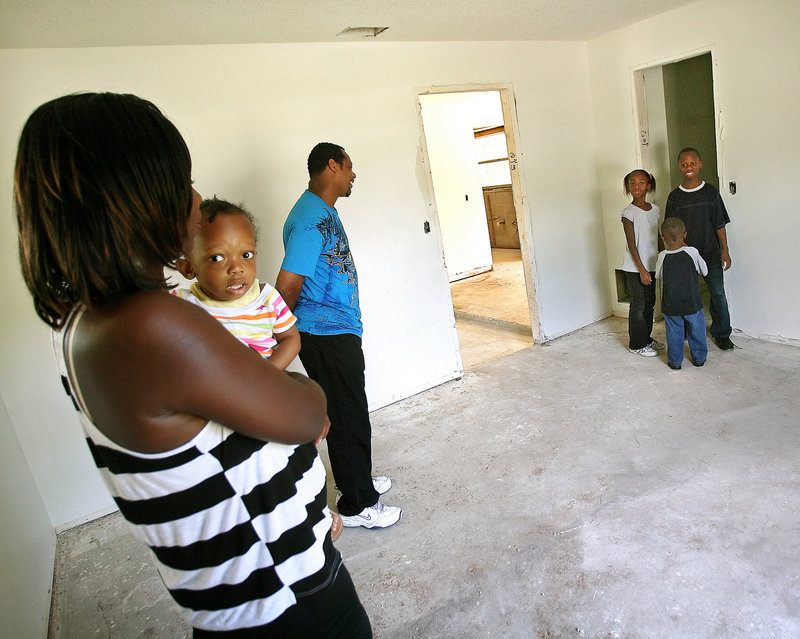ORLANDO, Fla. – Faced with the realities of the foreclosure crisis, nonprofit homebuilder Habitat for Humanity is adding a piece of equipment in its tool chest: a sledgehammer.
After decades of rallying volunteers to build new houses for low-income families, the international nonprofit’s Orlando chapter has started using federal funds to purchase and rehab older houses vacated by owners who could not pay their mortgages.
“Unfortunately, this is part of the foreclosure crisis,” said Dee Danmeyer, executive director of Orlando Habitat for Humanity. “We’re trying to do something good with what’s happened here. … This is definitely new for Central Florida.”
Bruce Stephens and his family have been tearing out old carpets, cabinets and even a few walls at a Pine Hills, Fla., foreclosure that is the first of five being reclaimed by Habitat this year with federal Neighborhood Stabilization Program funds.
The family has been living in a two-bedroom apartment and, if not for the foreclosure renovation, faced waiting several years to get into Habitat’s new Stag Horn town-home project west of Orlando.
“It makes no difference that this is renovated,” said Stephens, who must invest 300 to 500 hours with the nonprofit to qualify for a Habitat house. “For us to even have a house is a blessing.”
Orlando and Habitats nationally have dabbled in renovations in the past, but new federal funding to reclaim foreclosures has ramped up the rehabs.
Earlier this month, Habitat for Humanity International forged a partnership with the National Community Stabilization Trust. The two-year agreement allows local Habitat affiliates to work with financial institutions to take a “first look” at new foreclosures about to hit the market.
If the groups can make the numbers work with the purchase price, renovation costs and mortgage amount, they can then tap Neighborhood Stabilization Program funds to purchase and rehab the properties.
Foreclosures take some imagination to see the potential, Danmeyer said.
“They can look beyond nasty carpets and smells and old cabinets and see their dream home,” she said.
Even with new finishes, appliances and sometimes roofs and air-conditioning systems, the rehabbed foreclosures are also less expensive than new construction. With federal funds distributed through Orange County, Habitat purchases the foreclosures for $20,000 to $45,000 and invests an additional $20,000 to $30,000.
The Stephens family will pay about $450 to $500 a month, which includes taxes and insurance. In comparison, a town home at Stag Horn would cost about $650 a month, which includes all costs — even association fees.
The shift from new homes to renewed older ones comes just as Habitat was named one of the country’s top builders by Builder magazine. With 5,294 homes closing last year, Habitat moved up three spots in the ranking from 11th in 2008 to eighth in 2009.
The group’s renovation work has been growing, with Habitat affiliates repairing 710 homes nationwide in 2009, up from 621 homes in 2008.
In Florida, Orlando’s Habitat completed 11 houses last year and 15 in 2008. The group hopes to close on 24 homes this year, which includes the Stag Horn town homes and five renovated foreclosures.
In the past, when Habitat came into a neighborhood, cleared a lot and got volunteer help to erect a new home, the neighbors took notice, prompting them to start painting their porches and otherwise revive their homes, Danmeyer said.
It will be interesting, she said, to see whether the foreclosure renovations instill that same kind of neighborhood pride.
Bruce Stephens said he likes what he has seen so far on Kirk Street.
“We met the neighbors, and it’s like a perfect house for us,” he said. “It even comes with a two-car garage, and the new ones don’t always have garages.”
Send questions/comments to the editors.



Success. Please wait for the page to reload. If the page does not reload within 5 seconds, please refresh the page.
Enter your email and password to access comments.
Hi, to comment on stories you must . This profile is in addition to your subscription and website login.
Already have a commenting profile? .
Invalid username/password.
Please check your email to confirm and complete your registration.
Only subscribers are eligible to post comments. Please subscribe or login first for digital access. Here’s why.
Use the form below to reset your password. When you've submitted your account email, we will send an email with a reset code.